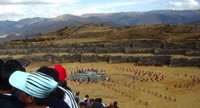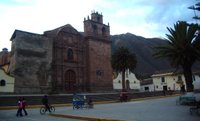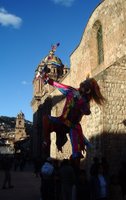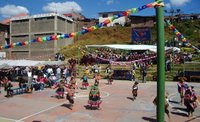6/15-18
Inca Trail (s/198 charged by Instituto Nacional de Cultura) to
Machu Picchu.
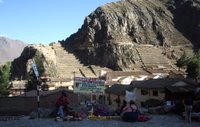
5:30am hotel pickup. Half an hour later, after counting maybe the 10th time, one British boy going to the airport finally realized that he was on a wrong bus! Breakfast at
Ollantaytambo (km 68) an hour later. Road ends at km 82 (2600m). After loading all gears, buying poles and straps, our group proceeded to the first check point.

They really took this seriously. Passport stamped, number verified. My last name was misspelled, but they didn't catch it.
The trail follows Urubamba River (as was the bus/train), with a view of Mt Veronica, just before Willkarakay, our first stop.


On this grassy plateau, Ali gave us a lecture on Inca agriculture at the hillside ruin
Patallacta (or Llactapata, 2650m) just over the bluff. I was glad to sit down and dump my backpack for awhile even though I wasn't carrying much.
From here, the slope picked up. We lunched at Hatunchaca (2950m) around 1:30pm. A treat (as other meals). A tent was set up, and beside it placed 5-6 plastic basins with water, soap and towel. Three courses: avocado salad, instant soup, breaded trout over rice. Everyone took a nap afterwards.
Uneventful afternoon. A brief stop at
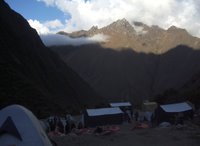
the last community on the trail Wayllabamba (3100m). A chicha window here boasts "we accept visa, master card". We reached the camping site Yuncachimpa (3300m) around 4:30 and had tea and cookies at 5pm.

Then a
formal introduction of each porter and every paying customer. 14 porters aged 21 to 51 (most under 30), worked on this trail for 2 to 10 years (most 4). Each was allowed to carry up to 20kg, including all tents, food, cooking utensils, and stupid plastic chairs. 14 gringos: 2 Finn couples, 2 Singapore brothers, 2 New Zealanders, 1 Aussie, 1 British, 4 from Seattle (coincidently as we learned later, they flew home on the very same planes as we did) !!!
Dinner at 7: soup, chicken, desert. The night sky was splendid.
Total for the day, about 16km.
Day 2. ~14km, the toughest. Up at 7, breakfast (bread, jam, tea, instant coffee/coco, hot pancake?), on the road at 8. Reached the first pass Abra de
warmi wañusca (meaning
dead woman, 4200m) around 10:15. It was a long haul. I was completely out of breath, even felt a bit drowsy towards the top. On the way, many of us tried to chew coca leaves. Even though everyone was sweating in T-shirts on the way up, it was freezing at the pass. Foggy all the way down to Paqaymayu (the largest camp site on the trail, 3500m), our lunch stop.
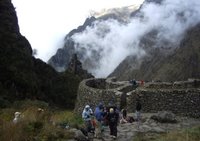
Now time to climb again. On the way, we paused at
Runkurakay (3800m), a small round Inca ruin, served as a watch tower or a
tambo for messenger relays.
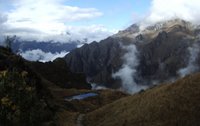
A small lake (the only one on this trail) at Qochapata just before the 2nd pass at 3950m.
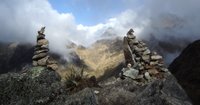
Those who still had energy left spent a few minutes scrambling up a big boulder on the right of the pass.

There was a side trail going up to
Sayaqmarka (3600m), shortly before the bottom of the valley. Too foggy to see anything. It started raining soon afterwards. By the night fall, it poured. Our camp site at Chaquiqocha (3680m) was on the edge. Bathroom required a 10-minute hike. Now you can imagine what happened at night when one needed to relieve some pressure in the bladder.
Day 3. ~ 9km. Rain stopped.

Cloud forest all day. Passed a couple of Inca tunnels, many wet plants and hidden birds. Walked over the 3rd pass (3670m) unnoticed.
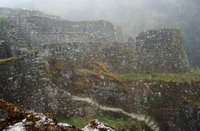
Foggy most of the morning. Couldn't see much of
Phuyupatamarka (3600m), a long chain of Inca baths. Supposed to be well preserved. Dommage!

From now on, steep and narrow trail downhill. At a power line tower (yes!), the trail splited in two. We took a longer / gentler route to visit
Intipata (2850m), adjacent to Machu Picchu mountain. A set of steep terraces.
Arrived at the huge camping ground (the only place that offers hot shower on the trail. s/5. long queue.) around 1pm.

After lunch: soup, beef stroganoff, veggie and rice, Ali took us to
Wiñay Wayna, a stroll away.

Its vast terraces were in perfect order. For some unknown reason, I fell sick in the afternoon, didn't go for the tea, when the rest of us were collecting tips for the porters. At dinner, as soon as I swallowed a spoonful of soup, I threw up everything since lunch, and felt much better. But I couldn't eat for the rest of the trek, except for hot tea and a bit of dry bread. After dinner, it was the funny ceremony of handing the tip to the porters, as we would part the next morning. Apart from expressing gratitude (from both sides), there involved a bit singing and dancing. We all enjoyed it in the now terribly crowded tent.
Day 4. ~4km.
Machu Picchu. Up at 4, out by 5am. 10 minutes walk with flash light to the last checkpoint, which opens at 5:30am. We were the first group to arrive. By the time we reached the Sun Gate, the sun has shined its first rays on Wayna Picchu. Now, the first glimpse of Machu Picchu. It was GRAND!

After a bathroom stop (s/0.5) and luggage check-in (free), we were herded through a high priest's house (notably evenly shaped stones of the wall), an astronomical observatory (with two trapezoid windows, one of which opens directly towards the sun at winter solstice), the royal tomb, the three-windowed temple,

the garden with some coca plant, and finally at Intiwatana (the sun temple, whose large slab of stone shaped in Southern Cross perfectly aligned to magnetic north). Then we were let loose until 2pm.
1 hr hike up
Wayna Picchu (an absolute must. Need to check in at the trail head no later than 1pm? and check out when leaving) for the moon temple and the splendid view of the entire Machu Picchu site and the surrounding mountains. The trail is extremely steep and narrow. At times only half my feet could land on the steps, and had to use all four limbs at the top!

After coming down from Wayna Picchu, visited the Temple of Condor, the Mortars, some of the storage rooms, the massive terraces, and photo-ed the llamas sent by the tourism office.

We took the bus ($6) at around 1:30 down to Agua Caliente, an unimpressive town despite the gorgeous setting. Most tourists were crowded on the overpriced side of the river. Walk over the bridge and venture beyond the train station, you'll get a better local flavor. Train at 3:55pm from Agua Caliente (PeruRail, $44 on class turismo for backpackers) to Cusco (110km, 4 hrs). Crowded and smelled of dirty socks! Everyone had a seat, but very little leg room. The first half of the journey was pleasant, along the Urubamba River. The rest was painfully slow: zigzagging over mountain passes. At one of the stops, greyhound-like buses tried to lure passengers out. They claimed to be 15 min. to Cusco, and charged s/15, while our train still had over an hour to go. If it were not for the promise that someone from Andean Life would meet us at the train station with our luggage, I would jump off the train. Alas, a bus did come to meet us and then circled around the town to every hotel. No bags!

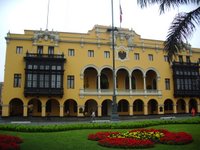 It was ugly all the way in. However, Plaza Mayor is in full colonial glory, flanked by the cathedral to the east, Palacio de Gobierno to the north (a replica of Pizarro's residence once stood here), and Palacio Municipal (city hall) to the west. Guard change M-Sat 11:45-12:15 inside the gate of presidential palace. To visit, make a reservation at least one day ahead at the tourism office 201 Jr. de la Union, 311-3908 or www.presidencia.gob.pe.
It was ugly all the way in. However, Plaza Mayor is in full colonial glory, flanked by the cathedral to the east, Palacio de Gobierno to the north (a replica of Pizarro's residence once stood here), and Palacio Municipal (city hall) to the west. Guard change M-Sat 11:45-12:15 inside the gate of presidential palace. To visit, make a reservation at least one day ahead at the tourism office 201 Jr. de la Union, 311-3908 or www.presidencia.gob.pe. The only thing survived the 1746 earthquake is the small bronze fountain (1651 by Pedro de Noguera) at the center of the plaza.
The only thing survived the 1746 earthquake is the small bronze fountain (1651 by Pedro de Noguera) at the center of the plaza. In the center is 40-some-seat wooden choir ensemble carved by Pedro de Noguera.
In the center is 40-some-seat wooden choir ensemble carved by Pedro de Noguera.  Below, all archbishops of Lima repose in the small crypt. It also houses the very first Peruvian university diploma. The declaration of independence was signed in this room in 1821.
Below, all archbishops of Lima repose in the small crypt. It also houses the very first Peruvian university diploma. The declaration of independence was signed in this room in 1821. A much more interesting church is Convento de San Francisco (s/5, free Spanish guide). Some priceless treasures here: a 2-story Franciscan library with over 25000 rare books, a bamboo dome able to withstand any quake, a painting of last supper with Peruvian food (guinea pig, potatoes, ...), and
A much more interesting church is Convento de San Francisco (s/5, free Spanish guide). Some priceless treasures here: a 2-story Franciscan library with over 25000 rare books, a bamboo dome able to withstand any quake, a painting of last supper with Peruvian food (guinea pig, potatoes, ...), and  the beautiful cloister (now half as what used to be) inlaid with Sevillian tiles and murals depicting the life of St. Francis of Assisi.
the beautiful cloister (now half as what used to be) inlaid with Sevillian tiles and murals depicting the life of St. Francis of Assisi.  An eerie highlight is the catacombs, narrow underground passages containing skulls and bones of over 25000 bodies, neatly arranged for photos. Before the city cemetery was opened in 1808, corpses were dumped under this church. Now only Franciscan brothers can be interred here.
An eerie highlight is the catacombs, narrow underground passages containing skulls and bones of over 25000 bodies, neatly arranged for photos. Before the city cemetery was opened in 1808, corpses were dumped under this church. Now only Franciscan brothers can be interred here. Miraflores, a well-to-do suburb bordering Pacific ocean. As the sun sets down, Parque Kennedy comes to life. A dozen venders set up their second-hand stalls. Even kids came out to play under street lights. I enjoyed a box of sweet concoction of hot porridge and purple fruit syrup, topped with shreds of coconut. Also bought a bottle of pisco sour in the crowded vicinity.
Miraflores, a well-to-do suburb bordering Pacific ocean. As the sun sets down, Parque Kennedy comes to life. A dozen venders set up their second-hand stalls. Even kids came out to play under street lights. I enjoyed a box of sweet concoction of hot porridge and purple fruit syrup, topped with shreds of coconut. Also bought a bottle of pisco sour in the crowded vicinity.

